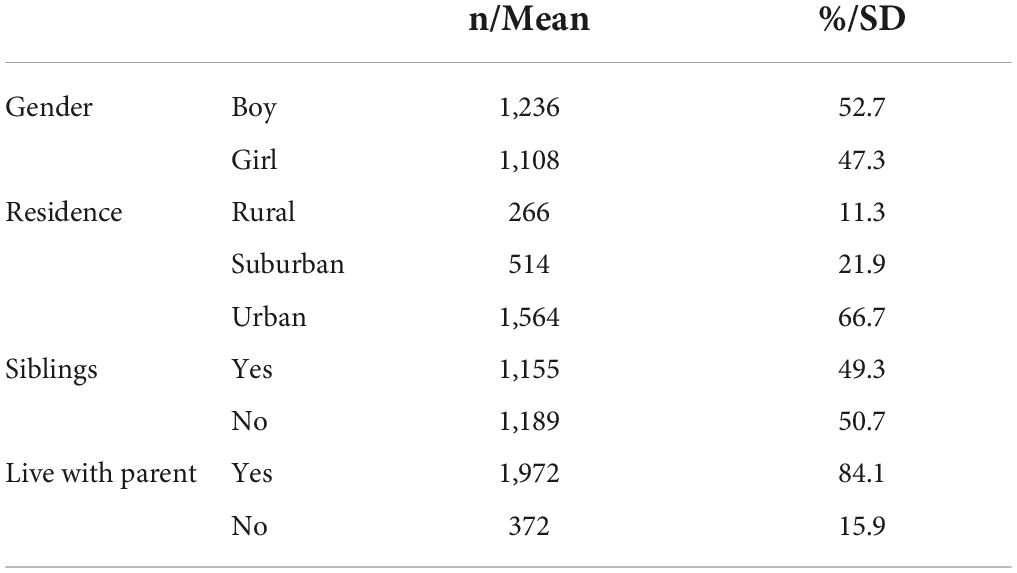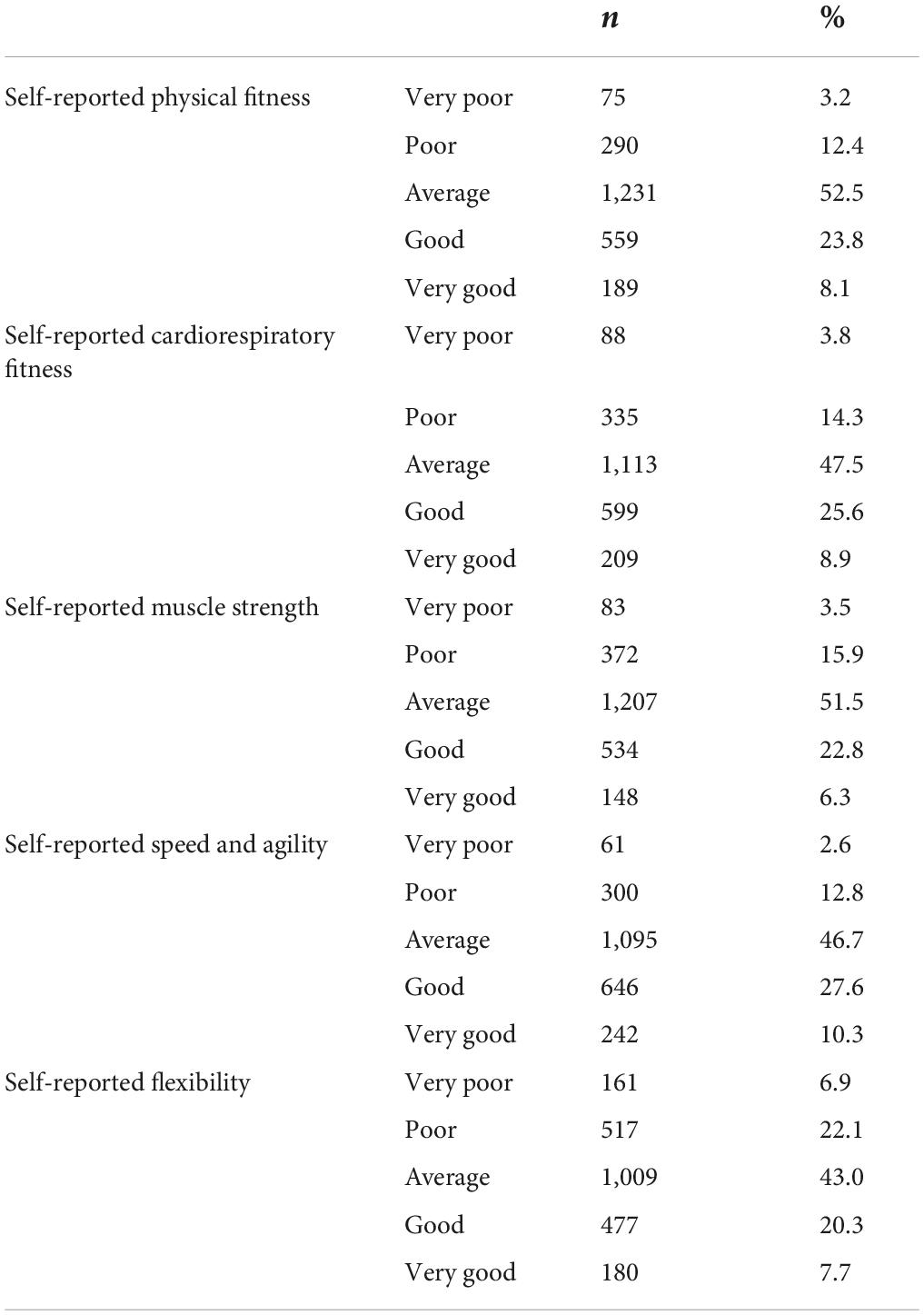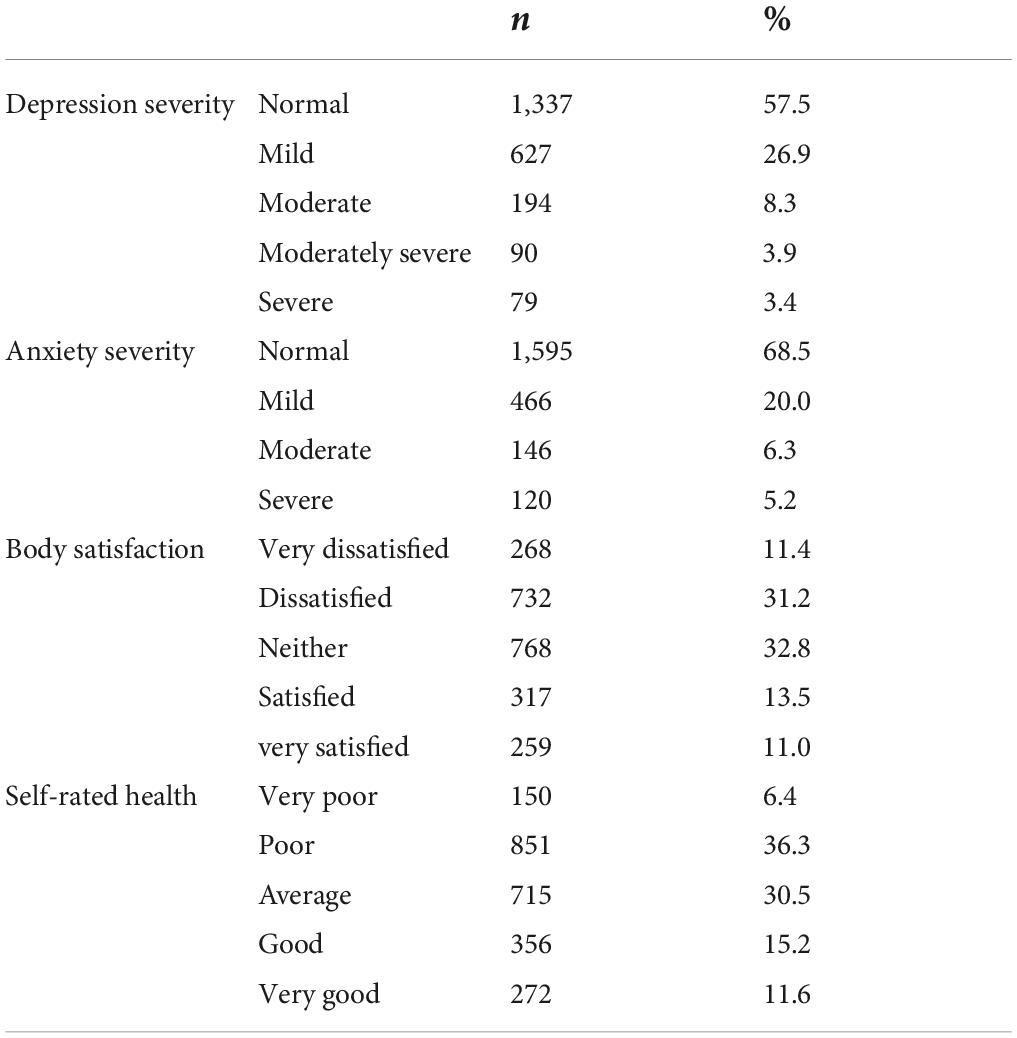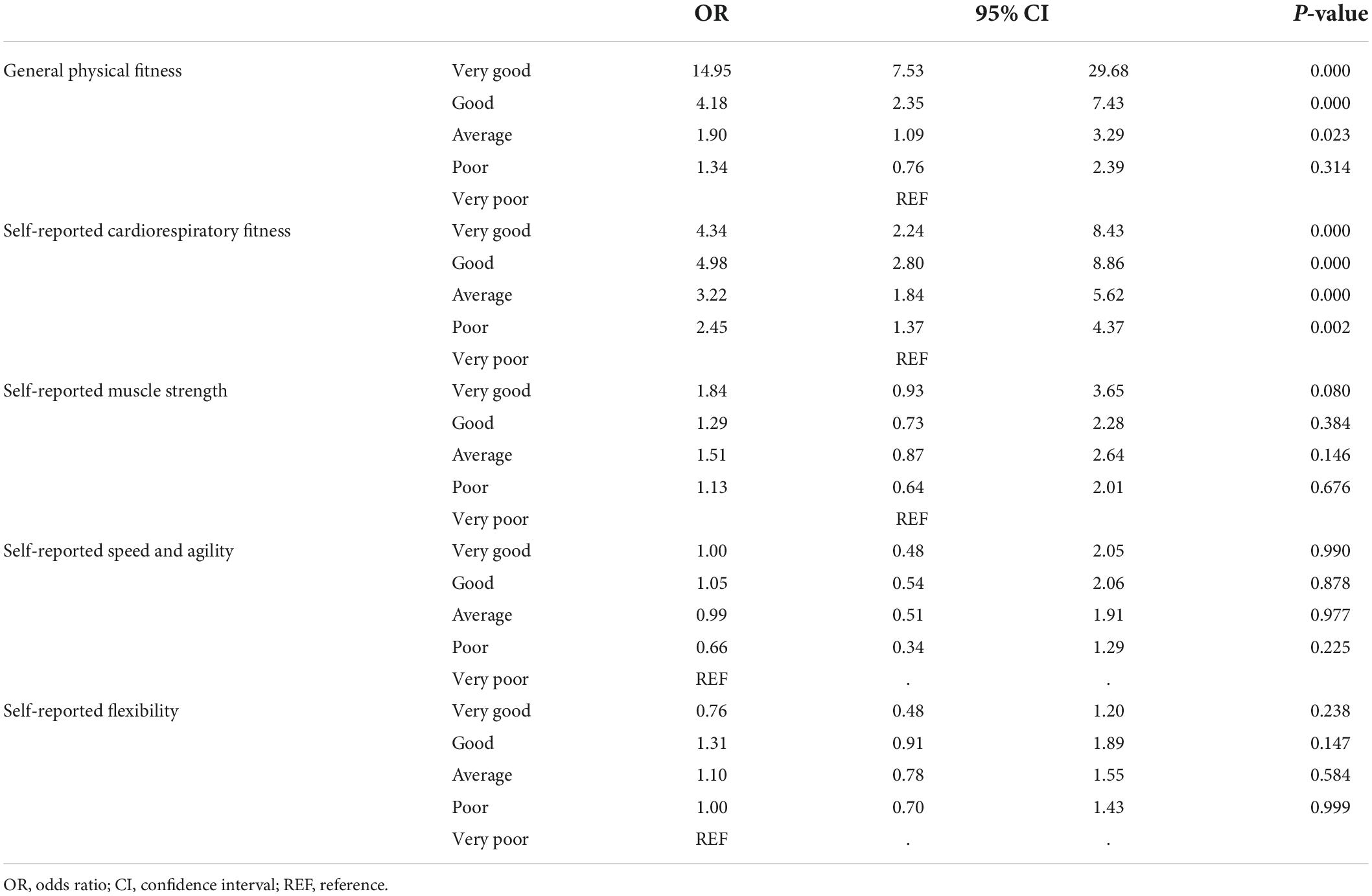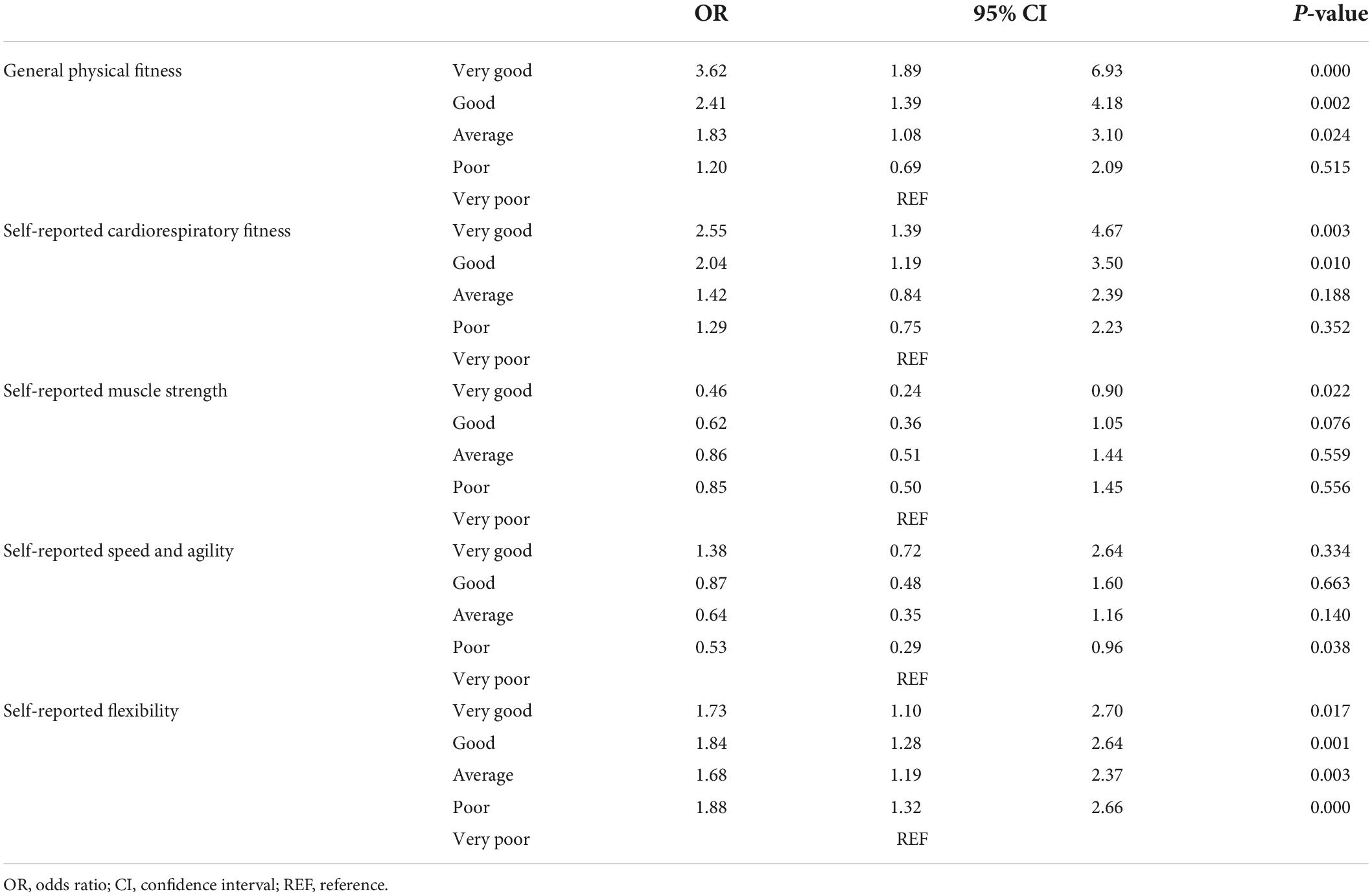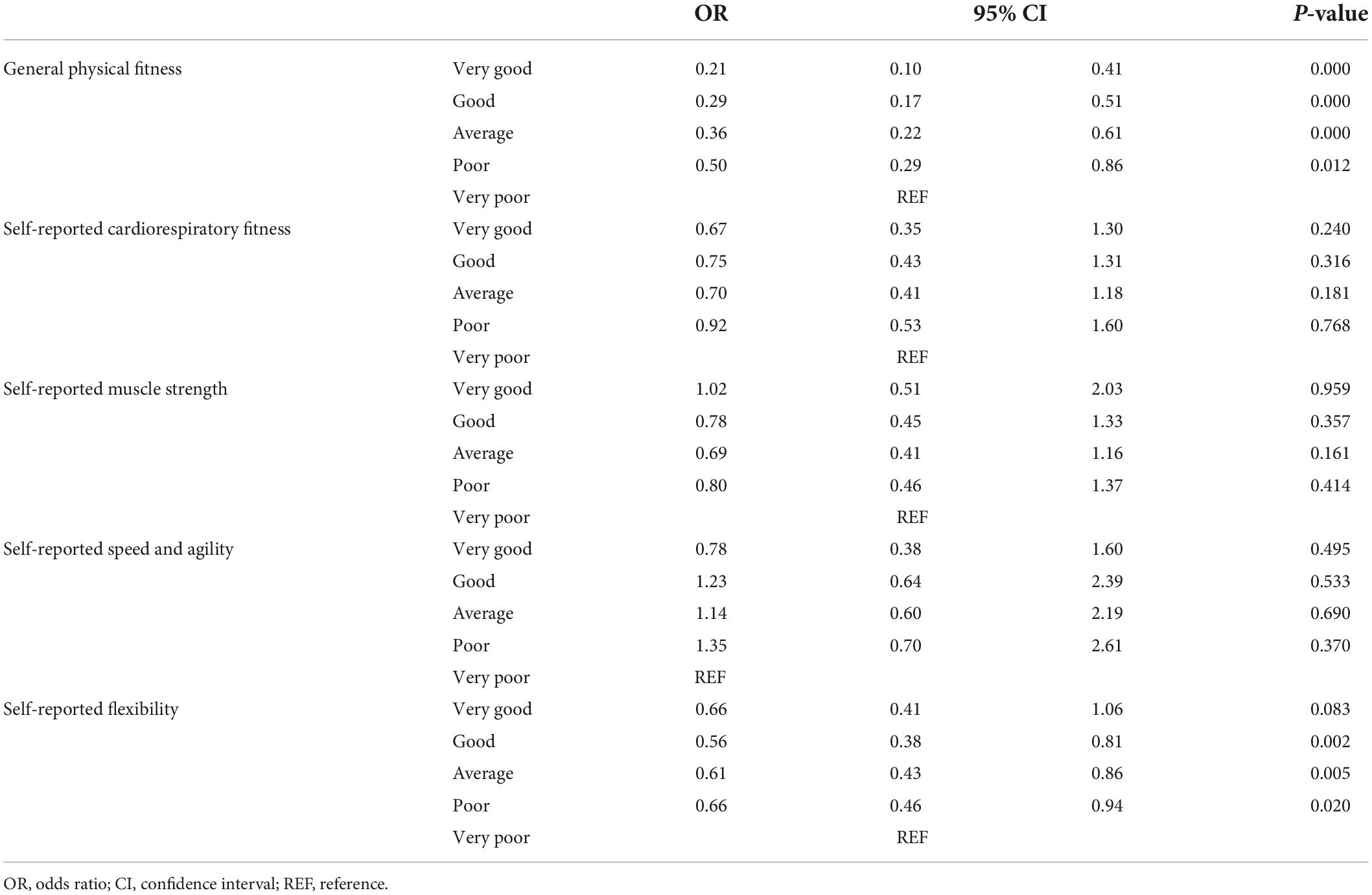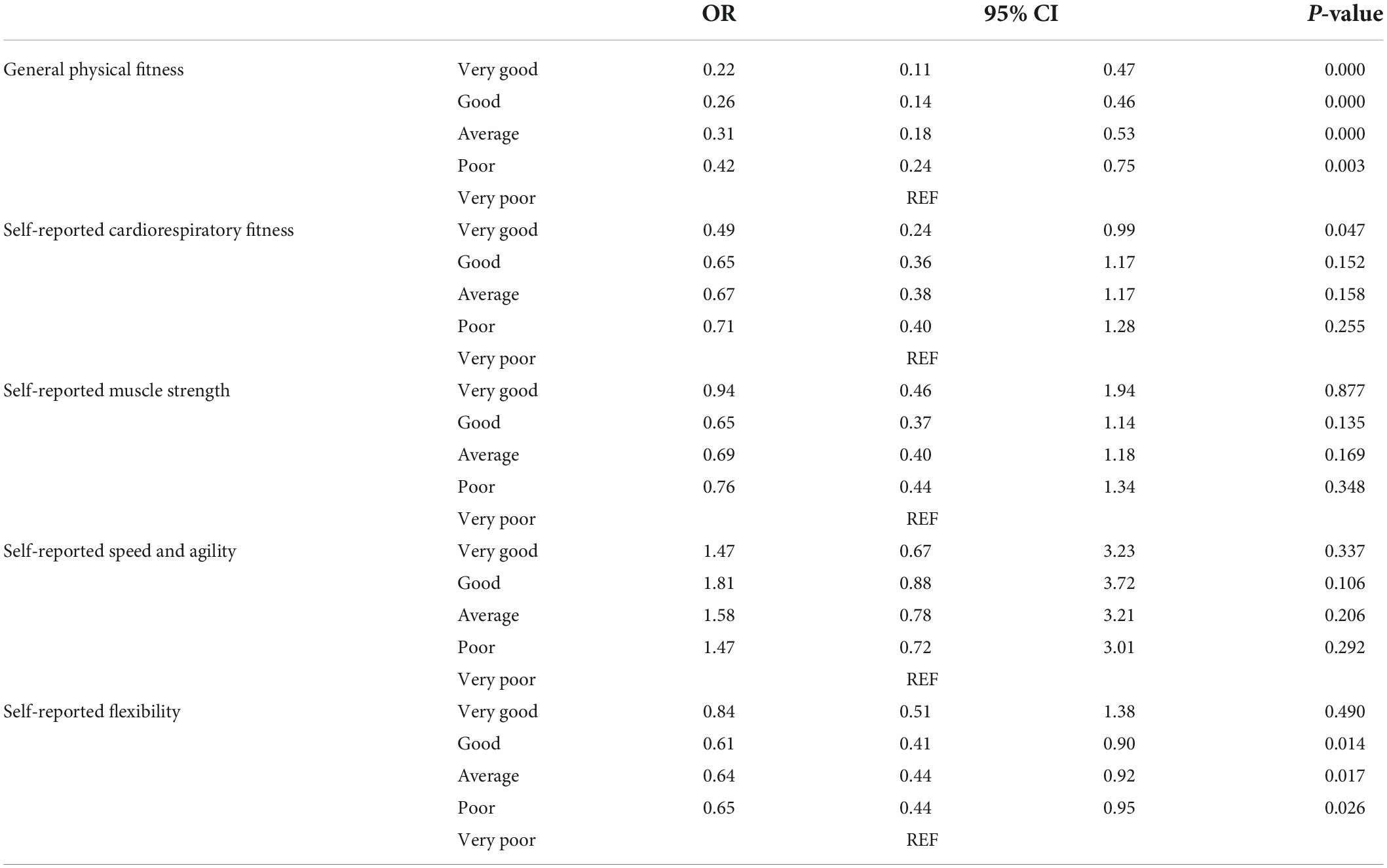- 1School of Physical Education and Humanity, Nanjing Sport Institute, Nanjing, China
- 2Centre for Active Living and Learning, University of Newcastle, Callaghan, NSW, Australia
- 3College of Human and Social Futures, University of Newcastle, Callaghan, NSW, Australia
- 4School of Physical Education, Shanghai University of Sport, Shanghai, China
Background: Physical activity (PA) and Physical fitness (PF) have received tremendous attention in the field of physical and mental health. However, limited attention has been given to the associations of self-reported physical fitness with some health-related outcomes. Given the COVID-19 pandemic is still active in many Chinese regions, assessing health-related physical fitness (HRPF) in adolescents using field-based assessment (such as a shuttle run for cardiorespiratory fitness) is unrealistic, therefore, this study was conducted via a self-reported questionnaire.
Purpose: The present cross-sectional study was aimed at delving into the relationship between self-reported physical fitness with self-rated health, depression, anxiety, and body satisfaction in adolescents. Three thousand eight hundred and seven study participants from 12 public schools in South-eastern China were recruited and 2,407 of them provided valid data on variables that this study needed for analysis.
Materials and methods: Study participants were asked to self-report their sociodemographic factors (e.g., sex, grade, age), independence, and outcomes. Generalized linear models were used to explore the associations of self-reported physical fitness (comprising general physical fitness, cardiorespiratory fitness, muscular strength, speed and agility, and flexibility) with depression, anxiety, and body satisfaction. A total of 2,407 children and adolescents with a mean age of 13.82 (±2.1) years were included in the final study analysis.
Results: Higher self-reported levels of general physical fitness and cardiorespiratory fitness were associated with better self-rated health, and body satisfaction but with lower risks of depression and anxiety.
Conclusion: The current study offered evidence on the roles of self-reported physical fitness and health-related outcomes. To facilitate health in children and adolescents, advocating fitness education, and promotion could be a feasible approach.
Introduction
There is a causal relationship between physical activity (PA) and physical fitness (PF) (Zhang et al., 2022). PA has been considered one of the most significant health-related aspects of the lives of children and adolescents (Bermejo-Cantarero et al., 2021; Ren et al., 2021). It is well-established that regular engaging PA has proven to be a vital method for improving body and tissue functions (D’Isanto et al., 2019; Chen and Yan, 2020; Ren et al., 2021). Evidence demonstrates that regular PA can prevent and treat physical diseases (Eather et al., 2013; Lin and Yan, 2020; Shen et al., 2020), as well as play a crucial role in improving mental health (Stanton et al., 2014; Liu et al., 2022).
It is widely accepted that PF can be evaluated as the comprehensive ability of the body to adapt to the surrounding environment (Ullah et al., 2012; Chen et al., 2022; Shi et al., 2022). The definition endowed by Marques et al. (2017) is that it enables everyone to choose the most suitable form and intensity of exercise for their own needs in all kinds of situations to improve their physical fitness and maintain the best health. The authors summarized fitness as the support of four factors, including the ability to perform physical activities that require speed, endurance, strength, and flexibility (Marques et al., 2017). Physical fitness is divided into health-related and skill-related health (Grier et al., 2017; Smits-Engelsman et al., 2020). The five components that get involved in health-related physical fitness (HRPF) include cardiorespiratory fitness, body composition, muscle strength, muscle endurance, and flexibility (Gu et al., 2016; Kim et al., 2021). There is considerable evidence that increasing HRPF levels among adolescents have health and academic benefits (Cattuzzo et al., 2016). For instance, adolescents with high HRPF levels are only less likely to develop cardiovascular disease later in life (Baumgartner et al., 2020). Adolescents’ cardiopulmonary health has a positive correlation with their academic performance due to its promoting effect on psychological emotion and learning concentration (Bailey et al., 2009; Padilla-Moledo et al., 2020; Liu et al., 2022), and a study by Del Giudice et al. (2021) found that a lack of daily step counts would have higher odds of being hypogonadal. Muscle health, such as strength and endurance, makes adolescents with low-risk obesity more likely to be active in physical activities (Malm et al., 2019; Chen and Yan, 2020; Lin and Yan, 2020; Comeras-Chueca et al., 2021; Gu et al., 2022). Moreover, a random control trial study by Mavilidi et al. (2021) found that PF can significantly improve children and adolescents’ cognitive control, working memory, and subjective vitality in a school setting. Of note, cross-sectional research has revealed that children and youth with higher fitness levels have greater hippocampal volume and memory performance compared with lower-fit children (Chaddock et al., 2010). It can be explained that regular engaging PT could stimulate angiogenesis and neurogenesis in areas of the brain, which ultimately influence cognitive performance (Leahy et al., 2020).
Self-reported physical fitness through questionnaire scale tools such as comprehensive evaluation of adolescent health contains four independent variables, including health, anxiety, as well as body satisfaction (Moliner-Urdiales et al., 2010; Barnes et al., 2020). First and foremost, self-rated health shows a positive correlation with physical fitness, and the self-rated health assessment of adolescents is affected by gender and grade (Vingilis et al., 2002; Warnoff et al., 2016). For example, according to Schrotenboer’s (2018) interview data in 2018, male students were significantly more satisfied with their physical and mental conditions and learning status than that female students, showing the differences in psychological characteristics and content of attention between men and women (Schrotenboer, 2018). They also paid less attention to their health and behavior, and their emotional experiences were less profound than those of their female counterparts. What’s more, depression and anxiety are both manifestations of emotional loss, which can cause great trouble to teenagers’ life and studies (Michl et al., 2013). In terms of these two indicators, teenagers who think their mental state is relatively satisfied generally argue that their physical fitness is at an intermediate or upper level (Mulasi-Pokhriyal and Smith, 2010; Csikszentmihalyi and Hunter, 2014). However, teenagers who rate themselves poorly also have lower health ratings and are more likely to be academically disadvantaged (Suldo and Shaffer, 2008). Thirdly, body satisfaction is often a factor that determines whether teenagers have emotional problems, and it is mainly attributed to their confidence in their appearance and body (Carlson Jones, 2004; Presnell et al., 2004).
Some studies get involved in the degree of interference of external factors on adolescents’ self-health cognition and life satisfaction. Novak et al. (2017) suggested that there was a significant correlation between values and life satisfaction in special fields, but the correlation coefficients were all very low. By contrast, the correlation between self-concept and life satisfaction was higher, implying that the relationship between self-concept and life satisfaction might be closer than that between values input from the external environment and life satisfaction (Brillhart, 2005). At the same time, Galán et al. (2013) took regional and family environment as dependent variables to reveal the overall satisfaction of urban students and the satisfaction score of school and living environment was significantly higher than that of rural students. As a result, it is suggested that schools and communities should make efforts to reinforce adolescent sports activities and health evaluation systems to make sure the establishment of basic life satisfaction for adolescents (Oberle et al., 2011; Padilla-Moledo et al., 2020).
With the COVID-19 pandemic still ongoing in many Chinese areas, assessing HRPF in youth using field-based assessment (such as a shuttle run for cardiorespiratory fitness) is unrealistic. Therefore, finding an alternative to assess HRPF in adolescents is necessary. The International Fitness Scale (IFIS) is an option that can consider adolescents’ HRPF conveniently (Ortega et al., 2011). This study was targeted at further estimating the relationship between self-reported fitness and health-related independent variables to highlight the role of fitness concerning self-rated health, depression, anxiety, and body satisfaction by using a sample of Chinese adolescents.
Materials and methods
Study design and participants
This cross-sectional study has been conducted in south-eastern China from March to October 2021. Using convenience sampling, 12 public schools were invited, and these schools were located in four cities in south-eastern China, that is, two high schools, five middle schools, and five elementary schools. For each school, we have randomly selected one or three classes, and a contact person is sent to each school. Once a potential school had expressed interest in this study, the first author emailed, phoned, or zoom called the representative(s) (e.g., the principal and administrative staff), to elaborate on the study requirements and process. The self-report scales were applied at the school by the staff teacher staff or headmaster of the school and they helped to manage and fill out the questionnaire in the form of paper-based. Having completed this step, we have recruited the first group of respondents comprising 3,807 adolescents and children (ages 11–17).
Study participants providing information on variables of interest were included in this study, while those who did not report data on any variables (e.g., independents, outcomes and covariates) of interest that this study needed were excluded from the initial sample. For this study and further analysis, a total of 2,407 study participants were included as they provided valid data on variables this study needed. Moreover, we have informed all the respondents and their guardians and parents that they are completely voluntary to take the survey. The study procedure and protocol have been performed upon approval from the Institutional Review Board (IRB) of the Shanghai University of Sport, and the grant number is 102772021RT071.
Physical fitness
With the 5-point Likert scale (very bad, bad, fair, good, and excellent), this study used the International Fitness Scale (IFIS) for assessing physical fitness. There are five components in IFIS, which are respectively general fitness, cardiorespiratory fitness, muscle strength, speed and agility, and flexibility. One of the questions used in this study is as follows: What is my general physical condition? (1 = very bad, 2 = bad, 3 = fair, 4 = good, 5 = excellent). The acceptable credibility and validity in teenagers (Ortega et al., 2011) have been reported by the scale. Furthermore, this study recruited 544 Chinese teenagers to attend credibility research. The research results demonstrated the acceptable credibility of IFIS in Chinese children and teenagers (weighted Kappa: 0.42–0.52 for the IFIS component, Cronbach alpha 0.72) (Bao et al., 2022).
Nine-item patient health questionnaire depression
The Chinese version of the 9-item Patient Health Questionnaire (PHQ-9) was applied to analyse depressive symptoms, including nine items relating to experiences of depressive symptoms in the past 2 weeks. Every item was scored in line with the Likert Scale with four grades, varying from 0 (no scoring) to 3 (almost scoring every day). The total scores ranged from 0 to 27, showing that the higher scores, the more serious depressive symptoms. The severity of depressive symptoms could be divided according to PHQ-9 scores: 20–27 (severe), 15–19 (moderately severe), 10–14 (moderate), 5–9 (mild), and 0–4 (minimal) (Levis et al., 2019). The psychometric properties of PHQ-9 have been tested on Chinese children, showing sufficient validity and reliability (Li et al., 2021).
Seven-item generalized anxiety disorder scale anxiety
Seven-item Generalized Anxiety Disorder Scale (GAD-7) was used to assess anxiety disorders, including seven items, in which each item’s response had a four-point Likert scale (ranging from 0 to 3) (Maggi et al., 2019). The total scores of GAD-7 ranged from 0 to 21, implying that the higher scores, the higher severity of anxiety. The severity of anxiety could be divided into severe (15–21), moderate (10–14), mild (5–9), and minimal (0–4) (Plummer et al., 2016). The translated GAD-7 has been widely applied among Chinese children and adolescents, showing acceptable validity and reliability (Sun et al., 2021).
Self-rated health
By asking the following questions, self-rated life satisfaction is measured. Generally, how do you consider your life satisfaction? The possible answers included: “Excellent (5),” “Very good (4),” “Good (4),” “Fair (3),” and “Poor (1)” (Mewes and Giordano, 2017). As for self-rated life satisfaction and its items, sound validity has been documented in previous studies (Zhang et al., 2019; Chai et al., 2020).
Body satisfaction
The status of body satisfaction is evaluated by asking the question “do you feel satisfied with your body weight of yours” There are five options for the answer ranging from “very satisfied” to “very dissatisfied” (Ren et al., 2018). In the analysis of data, the options of “somewhat dissatisfied” and “very dissatisfied” are combined as one option, that is, “dissatisfaction,” while “very satisfied” and “somewhat dissatisfied” is turned into “satisfaction.” Therefore, the status of body satisfaction has three types, satisfaction, neither and dissatisfaction.
Demographic characteristics
Age, sex, residence, siblings, living with parents and family affluence were collected as demographic characteristics in the current study. These variables were assessed via the following measurement questions: age (continuous), sex (boy or girl), residence (rural, suburban and urban), siblings (yes or no), living with parent (yes or no), and family affluence (0–10 scale).
Statistical analysis
All analyses were conducted using the Statistical Package for the Social Sciences v.26 (SPSS Inc., Chicago, IL, USA), and the alpha level was set at p < 0.05. Descriptive statistics (mean/standard deviation and percentage) were used to report on the basic characteristics of the study sample. Mean value with standard deviation was a continuous variable (e.g., age), whilst percentage was a categorical variable (e.g., sex, residence). Four regression models were established, including self-reported physical fitness and self-rated health, self-reported physical fitness and body satisfaction, self-reported physical fitness and depression, and self-reported physical fitness and anxiety. In each model, the indicators of self-reported physical fitness were entered into the model concurrently while controlling for covariates. A generalized linear model with ordinal logistic regression was used to achieve the association estimation above noted.
Results
Table 1 demonstrates that these samples were concentrated at the age of 13.9 (± 2.1), and were evenly distributed between boys and girls. Boys accounted for 5.4% more than girls, with 1,236 males and 1,108 girls. More information on the study participants can be found in Table 1.
Table 2 shows that adolescents are generally in their health assessment and choose “Average.” This answer accounted for the highest proportion in the five self-assessments of physical fitness, cardiovascular health, muscle strength, speed and agility, and flexibility. More than 50% of teenagers chose “Average” for Physical Fitness and Muscle Strength. Compared with the other four factors, adolescents had the most negative evaluation of flexibility, 161 of them thought very poorly, and more than 1/5 of them thought poor, 517 of them. In addition, in the sample, the evaluation of comprehensive Physical Fitness was more positive, except for average, accounting for 52.5%, and those who thought “good” and “very good” accounted for 31.9%.
Table 3 displays the emotion and satisfaction of adolescents. In terms of Depression severity and anxiety severity, they show a similar trend, which is more than half of the teenagers thought they were normal. However, in terms of body satisfaction, the proportion of Dissatisfied and Neither was close, both roughly 30%. Concerning self-rated health, most the youth choose poor health, the detailed information can be found in Table 3.
Table 4 presents that the independent variable analysis of self-rated health was strongly correlated with the result of self-rated physical fitness. In detail, compared with those who reported “very poor” self-rated health, adolescents who reported “very good” were more likely to have a high-level physical fitness ([very good] OR = 14.95, 95% CI: 7.53–29.68; [good] OR = 4.18, 95% CI: 2.35–7.43; [average] OR = 1.90, 95% CI: 1.09–3.29; [poor] OR = 1.34, 95% CI: 0.76–2.39). However, the evaluation of flexibility and speed were not the basis for them to identify high physical fitness, and there was no positive correlation.
Table 5 displays the association between self-reported physical fitness and body satisfaction. Similarly, compared with those who reported “very poor” body satisfaction, adolescents who reported “very good” were more likely to have a high-level physical fitness ([very good] OR = 3.62, 95% CI: 1.89–6.93; [good] OR = 2.41, 95% CI: 1.39–4.18; [average] OR = 1.83, 95% CI: 1.08–3.10; [poor] OR = 1.20, 95% CI: 0.69–2.09). However, youth who rated themselves low on flexibility or muscle strength were also likely to report better body satisfaction.
In contrast, Table 6 demonstrates adolescents who rated their higher depression were more likely to have lower physical fitness ([very good] OR = 0.21, 95% CI: 0.10–0.41; [good] OR = 0.29, 95% CI: 0.17–0.51; [average] OR = 0.36, 95% CI: 0.22–0.61; [poor] OR = 0.50, 95% CI: 0.29–0.86), which is showing a strong inverse correlation. Secondly, depression was also inversely correlated with the reported physical fitness scores, but not strongly correlated with cardiopulmonary health. There was no correlation between muscle strength and depression, that is, adolescents with high recognition of their muscle strength also had high levels of depression. Depression was not associated with flexibility, and there were no significant differences in depression among different grades of flexibility, more information can be found in Table 6.
Table 7 displays that anxiety and depression shows similar trends ([very good] OR = 0.22, 95% CI: 0.11–0.47; [good] OR = 0.26, 95% CI: 0.14–0.46; [average] OR = 0.31, 95% CI: 0.18–0.53; [poor] OR = 0.42, 95% CI: 0.24–0.75). More information can be found in Table 6.
Discussion
The primary of this study was to examine the association between self-reported fitness and health-related independent variables in adolescents (aged 11–17) by using the self-reported questionnaire, owing to the COVID-19 pandemic in many regions in China. Our study highlights the role of physical variables in adopting physical activity during adolescence, which proposes specific measures for communities and schools to improve adolescents’ physical and mental health through the mechanism of influence.
The results demonstrated that cardiorespiratory health, muscle health, and speed agility were all related to the perceived health condition, which is consistent with previous findings (Marques et al., 2017; Redondo-Tébar et al., 2019; Bermejo-Cantarero et al., 2021). The healthier respondents are more likely to evaluate themselves with higher scores on physical condition. Among the four components of evaluating general physical fitness, cardiorespiratory health and muscle strength show a significant relationship with self-reported physical health. However, no significant correlation has been identified between flexibility or speed and agility. This shows that in the evaluation of physical health, greater consideration has been given to cardiorespiratory health and muscle strength than flexibility, speed and agility. The same condition has also been detected in the scale of body satisfaction. Adolescents with lower self-perceived muscle strength and flexibility can also report a higher level of body satisfaction. Based on the above discussion, it can be drawn that adolescents report their overall fitness condition based on their perception of cardiorespiratory function and muscle strength. This result is in line with what Marques et al. (2017) have discovered, whose evidence showed a positive relationship between cardiorespiratory fitness and overall fitness level. Therefore, it is of great importance to improve adolescents’ overall health perception by improving their physical fitness level by concentrating on cardiorespiratory function other than improving flexibility and speed. The possible explanation is that people who get high scores in self-rated health tend to increase their perceived health through active exercise. Eriksen et al. (2013) further explained that Such self-motivated exercise formed a virtuous circle to encourage teenagers to keep fit. Jaakkola et al. (2019) also showed that teenagers who perform well in physical fitness tests are also full of confidence in their sports ability, which will further affect the social aspects of life achieved through sports activities.
In terms of emotional health conditions, the study measured the effects of two variables: depression and anxiety. Evidence showed that there was a negative relationship between the degree of depression and cardiorespiratory function. To be more specific, adolescents with poor cardiorespiratory function are more likely to score lower in their emotional functions. No significant correlation was discovered between the score of muscle strength and the level of depression in adolescents. This reflects the unique and important positive impact of cardiorespiratory function on teenagers’ emotional function. Correspondingly, the degree of anxiety and cardiorespiratory function are negatively correlated with each other. Adolescents with a higher level of anxiety are more likely to have poor cardiorespiratory health. Although a correlation was found between self-reported health and all health-related outcomes, the other three parameters did not show statistical significance with self-reported health. Nevertheless, despite the different voices, the majority of scholars recognized the positive correlation between overall physical fitness and emotional state. Many studies have been done to investigate the relationship between physical fitness and emotional wellbeing. For example, Harvey et al. (2018) believes that only 30 min of moderate exercise per week is related to a reduced risk of depression. However, some evidence indicated other factors that contributed more to mental health. For example, the data shown in this study is inconsistent with the results of Hallgren et al. (2020), who explored the relationship between cardiorespiratory health and mental health symptoms. This finding shows that it is exercise frequency, rather than cardiorespiratory factor, has a stronger correlation with mental health symptoms as the longer average weekly exercise time (lasting 1–2, 3–4, and 5–6 h, respectively) does not bring additional protection to the body. In addition, evidence also exists illustrating that only special forms of exercise, such as resistance training, have been proved to be effective in the treatment of emotional disorders and related symptoms (Gordon et al., 2018), but may not significantly improve cardiorespiratory levels. Besides physical exercise, the randomized controlled trial performed by Cunningham et al. (2021) revealed that both relaxation training and physical activities have buffering effects to reduce problematic emotions, indicating further research on different interventions to decide which one is more effective. In conclusion, cardiorespiratory health serves as an option to prevent common mental health symptoms, but necessarily the exclusive one.
Although the health measures adopted are self-evaluated, the results are consistent with other experimental research about physical fitness. Haverkamp et al. (2022) employed 361 adolescents to assess the relationship between their physical fitness and psychosocial health. The selected evaluation of physical and mental health is similar to this study: the evaluation of physical fitness includes muscle strength, speed and agility, as well as body mass index. Social mental health includes self-concept, depression, and anxiety. The results showed that adolescents with better cardiorespiratory function had higher self-concept and fewer depression and anxiety symptoms. In general, this evidence proves that cardiopulmonary function has an important impact on adolescents’ physical and mental health, which is not only reflected in self-perceived physical health but also reflected in mental health. The enhancement of muscle strength has a positive correlation with physical health but has little correlation with mental health. This indicates that schools and communities can pay more attention to the training of cardiopulmonary function and assist a certain degree of muscle strength training in enhancing the physical and mental state of adolescents. Some studies have proposed possible explanations for this result. Mücke et al. (2018) stated that young people with good cardiopulmonary and muscle functions will naturally participate in more sports activities. Sports have been proved to improve the level of endorphins in the brain and reduce the activity of sympathetic nerves, which can effectively reduce the psychological problems of teenagers (Nabkasorn et al., 2006; Shahr-Jerdy et al., 2012). In consequence, this study shed light on the importance of physical exercise to improve adolescents’ physical and mental health, especially cardiopulmonary training. The results also suggest that self-rated health and fitness level can be an important indicator to determine the health level of adolescents.
This study has had inherent limitations in its research design, measures, and participants. First of all, owing to the cross-sectional research design, the current study could not draw some causal conclusions; the directionality of the association between independent and outcomes could not be determined. Beyond that, this study utilized self-reported measures to collect data on all the variables, which were subject to recall bias and social desirability of the participants. Thirdly, as this study adopted a convenient and non-probabilistic sampling method, the research findings might be more regionally replicable than nationally replicable. Furthermore, the response rate was 63%, which was relatively low in the present study. Last but not least, although adolescents’ self-reported nature introduces several biases, the literature is consistent with self-reported validity and reliability; and self-reported use during the pandemic allowed continuing to assess physical fitness when it was impossible by objective methods. Given these limitations, future studies will be encouraged to address them to generate stronger evidence.
Conclusion
This study offered some evidence concerning the associations between self-reported physical fitness in children and adolescents with some mental health-related outcomes, highlighting the roles of self-reported physical fitness in preventing mental health disorders.
Data availability statement
The original contributions presented in this study are included in the article/supplementary material, further inquiries can be directed to the corresponding author.
Ethics statement
The study procedure and protocol have been performed upon approval from the Institutional Review Board (IRB) of the Shanghai University of Sport (102772021RT071). Written informed consent to participate in this study was provided by the participants’ legal guardian/next of kin.
Author contributions
CS and JY: writing – original draft. JY and LW: formal analysis. CS and HS: writing – review and editing as well as supervision. All authors contributed to the article and approved the submitted version.
Funding
This study was supported by the National Social Science Fund of China (Grant number 17BTY015).
Conflict of interest
The authors declare that the research was conducted in the absence of any commercial or financial relationships that could be construed as a potential conflict of interest.
Publisher’s note
All claims expressed in this article are solely those of the authors and do not necessarily represent those of their affiliated organizations, or those of the publisher, the editors and the reviewers. Any product that may be evaluated in this article, or claim that may be made by its manufacturer, is not guaranteed or endorsed by the publisher.
References
Bailey, R., Armour, K., Kirk, D., Jess, M., Pickup, I., Sandford, R., et al. (2009). The educational benefits claimed for physical education and school sport: An academic review. Res. Pap. Educ. 24, 1–27. doi: 10.1080/02671520701809817
Bao, R., Chen, S., Kastelic, K., Drenowatz, C., Li, M., Zhang, J., et al. (2022). Reliability of International Fitness Scale (IFIS) in Chinese Children and Adolescents. Children 9:531. doi: 10.3390/children9040531
Barnes, M., Abhyankar, P., Dimova, E., and Best, C. (2020). Associations between body dissatisfaction and self-reported anxiety and depression in otherwise healthy men: A systematic review and meta-analysis. PLoS One 15:e0229268. doi: 10.1371/journal.pone.0229268
Baumgartner, L., Weberruß, H., Oberhoffer-Fritz, R., and Schulz, T. (2020). Vascular structure and function in children and adolescents: What impact do physical activity, health-related physical fitness, and exercise have?. Front. Pediatr. 8:103. doi: 10.3389/fped.2020.00103
Bermejo-Cantarero, A., Álvarez-Bueno, C., Martínez-Vizcaino, V., Redondo-Tébar, A., Pozuelo-Carrascosa, D. P., and ánchez-López, M. S. (2021). Relationship between both cardiorespiratory and muscular fitness and health-related quality of life in children and adolescents: A systematic review and meta-analysis of observational studies. Health Qual. Life Outcomes 19:127. doi: 10.1186/s12955-021-01766-0
Brillhart, B. (2005). A study of spirituality and life satisfaction among persons with spinal cord injury. Rehabil. Nurs. 30, 31–34. doi: 10.1002/j.2048-7940.2005.tb00353.x
Carlson Jones, D. (2004). Body image among adolescent girls and boys: A longitudinal study. Dev. Psychol. 40: 823. doi: 10.1037/0012-1649.40.5.823
Cattuzzo, M. T., Dos Santos Henrique, R., Ré, A. H., de Oliveira, I. S., Melo, B. M., and de Sousa Moura, M. (2016). Motor competence and health related physical fitness in youth: A systematic review. J. Sci. Med. Sport 19, 123–129. doi: 10.1016/j.jsams.2014.12.004
Chaddock, L., Erickson, K. I., Prakash, R. S., Kim, J. S., Voss, M. W., VanPatter, M., et al. (2010). A neuroimaging investigation of the association between aerobic fitness, hippocampal volume, and memory performance in preadolescent children. Brain Res. 1358, 172–183. doi: 10.1016/j.brainres.2010.08.049
Chai, L., Xue, J., and Han, Z. (2020). School bullying victimization and self-rated health and life satisfaction: The gendered buffering effect of educational expectations. Child. Youth Serv. Rev. 116: 105252. doi: 10.1016/j.childyouth.2020.105252
Chen, S. T., and Yan, J. (2020). Prevalence and Selected Sociodemographic of Movement Behaviors in Schoolchildren from Low-and Middle-Income Families in Nanjing. China: A Cross-Sectional Questionnaire Survey. Children 7:13. doi: 10.3390/children7020013
Chen, Z., Chi, G., Wang, L., Chen, S., Yan, J., and Li, S. (2022). The Combinations of Physical Activity, Screen Time, and Sleep, and Their Associations with Self-Reported Physical Fitness in Children and Adolescents. Int. J. Environ. Res. Public Health 19: 5783. doi: 10.3390/ijerph19105783
Comeras-Chueca, C., Marin-Puyalto, J., Matute-Llorente, A., Vicente-Rodriguez, G., Casajus, J. A., and Gonzalez-Aguero, A. (2021). Effects of Active Video Games on Health-Related Physical Fitness and Motor Competence in Children and Adolescents With Overweight or Obesity: Systematic Review and Meta-Analysis. JMIR Serious Games 9: e29981. doi: 10.2196/29981
Csikszentmihalyi, M., and Hunter, J. (2014). “Happiness in everyday life: The uses of experience sampling,” in Flow and the foundations of positive psychology, ed. M. Csikszentmihalyi (Berlin: Springer), 89–101. doi: 10.1007/978-94-017-9088-8_6
Cunningham, K. B., Rogowsky, R. H., Carstairs, S. A., Sullivan, F., and Ozakinci, G. (2021). Methods of connecting primary care patients with community-based physical activity opportunities: A realist scoping review. Health Soc. Care Commun. 29, 1169–1199. doi: 10.1111/hsc.13186
Del Giudice, F. F., Glover, F., Belladelli, E., De Berardinis, A., Sciarra, S., Salciccia, A. M., et al. (2021). Association of daily step count and serum testosterone among men in the United States. Endocrine 72, 874–881. doi: 10.1007/s12020-021-02631-2
D’Isanto, T., D’Elia, F., Raiola, G., and Altavilla, G. (2019). Assessment of sport performance: Theoretical aspects and practical indications. Sport Mont J. 17, 79–82. doi: 10.26773/smj.190214
Eather, N., Morgan, P. J., and Lubans, D. R. (2013). Improving the fitness and physical activity levels of primary school children: Results of the Fit-4-Fun group randomized controlled trial. Prevent. Med. 56, 12–19. doi: 10.1016/j.ypmed.2012.10.019
Eriksen, L., Curtis, T., Grønbæk, M., Helge, J. W., and Tolstrup, J. S. (2013). The association between physical activity, cardiorespiratory fitness and self-rated health. Prevent. Med. 57, 900–902. doi: 10.1016/j.ypmed.2013.09.024
Galán, I., Boix, R., Medrano, M. J., Ramos, P., Rivera, F., Pastor-Barriuso, R., et al. (2013). Physical activity and self-reported health status among adolescents: A cross-sectional population-based study. BMJ Open 3: e002644. doi: 10.1136/bmjopen-2013-002644
Gordon, B. R., McDowell, C. P., Hallgren, M., Meyer, J. D., Lyons, M., and Herring, M. P. (2018). Association of efficacy of resistance exercise training with depressive symptoms: Meta-analysis and meta-regression analysis of randomized clinical trials. JAMA Psychiatry 75, 566–576. doi: 10.1001/jamapsychiatry.2018.0572
Grier, T. L., Canham-Chervak, M., Bushman, T. T., Anderson, M. K., North, W. J., and Jones, B. H. (2017). Evaluating injury risk and gender performance on health-and skill-related fitness assessments. J. Strength Cond. Res. 31, 971–980. doi: 10.1519/JSC.0000000000001805
Gu, J., Hong, J. T., Lin, Y., Yan, J., and Chen, S. (2022). Correlates of Meeting the Muscle-Strengthening Exercise Guidelines in Children and Adolescent. Front. Public Health 10:854100. doi: 10.3389/fpubh.2022.854100
Gu, X., Chang, M., and Solmon, M. A. (2016). Physical activity, physical fitness, and health-related quality of life in school-aged children. J. Teach. Phys. Educ. 35, 117–126. doi: 10.1123/jtpe.2015-0110
Hallgren, M., Kandola, A., Stubbs, B., Wallin, P., Andersson, G., and Ekblom-Bak, E. (2020). Associations of exercise frequency and cardiorespiratory fitness with symptoms of depression and anxiety-a cross-sectional study of 36,595 adults. Ment. Health Phys. Act. 19: 100351. doi: 10.1016/j.mhpa.2020.100351
Harvey, S. B., Øverland, S., Hatch, S. L., Wessely, S., Mykletun, A., and Hotopf, M. (2018). Exercise and the prevention of depression: Results of the HUNT cohort study. Am. J. Psychiatry 175, 28–36. doi: 10.1176/appi.ajp.2017.16111223
Haverkamp, B. F., Hartman, E., and Oosterlaan, J. (2022). Physical fitness and psychosocial health in a sample of Dutch adolescents. Prevent. Med. Rep. 25:101689. doi: 10.1016/j.pmedr.2021.101689
Jaakkola, T., Huhtiniemi, M., Salin, K., Seppälä, S., Lahti, J., Hakonen, H., et al. (2019). Motor competence, perceived physical competence, physical fitness, and physical activity within Finnish children. Scand. J. Med. Sci. Sports 29, 1013–1021. doi: 10.1111/sms.13412
Kim, S. W., Park, H. Y., Jung, H., Lee, J., and Lim, K. (2021). Estimation of health-related physical fitness using multiple linear regression in korean adults: National fitness award (NFA) 2015-2019. Front. Physiol. 12: 668055. doi: 10.3389/fphys.2021.668055
Leahy, A. A., Mavilidi, M. F., Smith, J. J., Hillman, C. H., Eather, N., Barker, D., et al. (2020). Review of high-intensity interval training for cognitive and mental health in youth. Med. Sci. Sports Exerc. 52, 2224–2234.
Levis, B., Benedetti, A., and Thombs, B. D. (2019). Accuracy of Patient Health Questionnaire-9 (PHQ-9) for screening to detect major depression: Individual participant data meta-analysis. BMJ 365: l1476. doi: 10.1136/bmj.l1476
Li, S., Schulte, E. M., Cui, G., Li, Z., Cheng, Z., and Xu, H. (2021). Psychometric properties of the Chinese version of the modified Yale Food Addiction Scale version 2.0 (C-mYFAS 2.0): Prevalence of food addiction and relationship with resilience and social support. Eat. Weight Disord. Stud. Anorexia Bulimia Obesity 27, 273–284. doi: 10.1007/s40519-021-01174-9
Lin, Y., and Yan, J. (2020). Muscle-Strengthening Activities and Sociodemographic Correlates among Adults: Findings from Samples in Mainland China. Int. J. Environ. Res. Public Health 17:2266. doi: 10.3390/ijerph17072266
Liu, S., Yu, Q., Hossain, M., Doig, S., Bao, R., Zhao, Y., et al. (2022). Meeting 24-h Movement Guidelines is Related to Better Academic Achievement: Findings from the YRBS 2019 Cycle. Int. J. Ment. Health Promot. 24, 13–24.
Maggi, M., Gentilucci, A., Salciccia, S., Gatto, A., Gentile, V., Colarieti, A., et al. (2019). Psychological impact of different primary treatments for prostate cancer: A critical analysis. Andrologia 51:e13157. doi: 10.1111/and.13157
Malm, C., Jakobsson, J., and Isaksson, A. (2019). Physical activity and sports—real health benefits: A review with insight into the public health of Sweden. Sports 7:127. doi: 10.3390/sports7050127
Marques, A., Mota, J., Gaspar, T., and de Matos, M. G. (2017). Associations between self-reported fitness and self-rated health, life-satisfaction and health-related quality of life among adolescents. J. Exerc. Sci. Fitness 15, 8–11. doi: 10.1016/j.jesf.2017.03.001
Mavilidi, M. F., Mason, C., Leahy, A. A., Kennedy, S. G., Eather, N., Hillman, C. H., et al. (2021). Effect of a time-efficient physical activity intervention on senior school students’ on-task behaviour and subjective vitality: The ‘Burn 2 Learn’cluster randomised controlled trial. Educ. Psychol. Rev. 33, 299–323. doi: 10.1007/s10648-020-09537-x
Mewes, J., and Giordano, G. N. (2017). Self-rated health, generalized trust, and the affordable care act: A US panel study, 2006–2014. Soc. Sci. Med. 190, 48–56. doi: 10.1016/j.socscimed.2017.08.012
Michl, L. C., McLaughlin, K. A., Shepherd, K., and Nolen-Hoeksema, S. (2013). Rumination as a mechanism linking stressful life events to symptoms of depression and anxiety: Longitudinal evidence in early adolescents and adults. J. Abnorm. Psychol. 122:339. doi: 10.1037/a0031994
Moliner-Urdiales, D., Ruiz, J., Ortega, F., Jiménez-Pavón, D., Vicente-Rodriguez, G., Rey-López, J., et al. (2010). Secular trends in health-related physical fitness in Spanish adolescents: The AVENA and HELENA studies. J. Sci. Med. Sport 13, 584–588. doi: 10.1016/j.jsams.2010.03.004
Mücke, M., Ludyga, S., Colledge, F., and Gerber, M. (2018). Influence of regular physical activity and fitness on stress reactivity as measured with the trier social stress test protocol: A systematic review. Sports Med. 48, 2607–2622. doi: 10.1007/s40279-018-0979-0
Mulasi-Pokhriyal, U., and Smith, C. (2010). Assessing body image issues and body satisfaction/dissatisfaction among Hmong American children 9–18 years of age using mixed methodology. Body Image 7, 341–348. doi: 10.1016/j.bodyim.2010.08.002
Nabkasorn, C., Miyai, N., Sootmongkol, A., Junprasert, S., Yamamoto, H., Arita, M., et al. (2006). Effects of physical exercise on depression, neuroendocrine stress hormones and physiological fitness in adolescent females with depressive symptoms. Eur. J. Public Health 16, 179–184. doi: 10.1093/eurpub/cki159
Novak, D., Štefan, L., Emeljanovas, A., Mieziene, B., Milanović, I., Janić, S. R., et al. (2017). Factors associated with good self-rated health in European adolescents: A population-based cross-sectional study. Int. J. Public Health 62, 971–979. doi: 10.1007/s00038-017-1015-0
Oberle, E., Schonert-Reichl, K. A., and Zumbo, B. D. (2011). Life satisfaction in early adolescence: Personal, neighborhood, school, family, and peer influences. J. Youth Adolesc. 40, 889–901. doi: 10.1007/s10964-010-9599-1
Ortega, F. B., Ruiz, J. R., Espana-Romero, V., Vicente-Rodriguez, G., Martínez-Gómez, D., Manios, Y., et al. (2011). The International Fitness Scale (IFIS): Usefulness of self-reported fitness in youth. Int. J. Epidemiol. 40, 701–711. doi: 10.1093/ije/dyr039
Padilla-Moledo, C., Fernández-Santos, J. D., Izquierdo-Gómez, R., Esteban-Cornejo, I., Rio-Cozar, P., Carbonell-Baeza, A., et al. (2020). Physical fitness and self-rated health in children and adolescents: Cross-sectional and longitudinal study. Int. J. Environ. Res. Public Health 17:2413. doi: 10.3390/ijerph17072413
Plummer, F., Manea, L., Trepel, D., and McMillan, D. (2016). Screening for anxiety disorders with the GAD-7 and GAD-2: A systematic review and diagnostic metaanalysis. Gen. Hosp. Psychiatry 39, 24–31. doi: 10.1016/j.genhosppsych.2015.11.005
Presnell, K., Bearman, S. K., and Stice, E. (2004). Risk factors for body dissatisfaction in adolescent boys and girls: A prospective study. Int. J. Eat. Disord. 36, 389–401. doi: 10.1002/eat.20045
Redondo-Tébar, A., Ruíz-Hermosa, A., Martínez-Vizcaíno, V., Cobo-Cuenca, A. I., Bermejo-Cantarero, A., Cavero-Redondo, I., et al. (2019). Associations between health-related quality of life and physical fitness in 4–7-year-old Spanish children: The MOVIKIDS study. Qual. Life Res. 28, 1751–1759. doi: 10.1007/s11136-019-02136-6
Ren, L., Xu, Y., Guo, X., Zhang, J., Wang, H., Lou, X., et al. (2018). Body image as risk factor for emotional and behavioral problems among Chinese adolescents. BMC Public Health 18:1179. doi: 10.1186/s12889-018-6079-0
Ren, T., Yan, J., and Sun, Q. (2021). Sociodemographic Correlates of Organized Sports Participation in a Sample of Middle School Students in China. Front. Public Health 9:730555. doi: 10.3389/fpubh.2021.730555
Schrotenboer, J. P. (2018). The Relationship Between Self-Reported BMI, Body Satisfaction and Weight Discriminatory Attitudes. Ph.D thesis. Minneapolis, MN: Capella University.
Shahr-Jerdy, S., Hosseini, R. S., and Gh, M. E. (2012). Effects of stretching exercises on primary dysmenorrhea in adolescent girls. Biomed. Hum. Kinet. 4, 127–132. doi: 10.2478/v10101-012-0024-y
Shen, H., Yan, J., Hong, J. T., Clark, C., Yang, X. N., Liu, Y., et al. (2020). Prevalence of physical activity and sedentary behavior among Chinese children and adolescents: Variations, gaps, and recommendations. Int. J. Environ. Res. Public Health 17:3066. doi: 10.3390/ijerph17093066
Shi, C., Chen, S., Wang, L., Yan, J., Liang, K., Hong, J., et al. (2022). Associations of sport participation, muscle-strengthening exercise and active commuting with self-reported physical fitness in school-aged children. Front. Public Health 10:873141. doi: 10.3389/fpubh.2022.873141
Smits-Engelsman, B., Neto, J. L. C., Draghi, T. T. G., Rohr, L. A., and Jelsma, D. (2020). Construct validity of the PERF-FIT, a test of motor skill-related fitness for children in low resource areas. Res. Dev. Disabil. 102:03663. doi: 10.1016/j.ridd.2020.103663
Stanton, R., Happell, B., and Reaburn, P. (2014). The mental health benefits of regular physical activity, and its role in preventing future depressive illness. Nursing 4, 45–53. doi: 10.2147/NRR.S41956
Suldo, S. M., and Shaffer, E. J. (2008). Looking beyond psychopathology: The dual-factor model of mental health in youth. Sch. Psychol. Rev. 37, 52–68.
Sun, J., Liang, K., Chi, X., and Chen, S. (2021). Psychometric Properties of the Generalized Anxiety Disorder Scale-7 Item (GAD-7) in a Large Sample of Chinese Adolescents. Healthcare 9:1709. doi: 10.3390/healthcare9121709
Ullah, S., Higgins, H., Braem, B., Latre, B., Blondia, C., Moerman, I., et al. (2012). A comprehensive survey of wireless body area networks. J. Med. Syst. 36, 1065–1094. doi: 10.1007/s10916-010-9571-3
Vingilis, E. R., Wade, T. J., and Seeley, J. S. (2002). Predictors of adolescent self-rated health. Can. J. Public Health 93, 193–197. doi: 10.1007/BF03404999
Warnoff, C., Lekander, M., Hemmingsson, T., Sorjonen, K., Melin, B., and Andreasson, A. (2016). Is poor self-rated health associated with low-grade inflammation in 43 110 late adolescent men of the general population? A cross-sectional study. BMJ Open 6:e009440. doi: 10.1136/bmjopen-2015-009440
Zhang, A., De Luca, S., Oh, S., Liu, C., and Song, X. (2019). The moderating effect of gender on the relationship between bullying victimization and adolescents’ self-rated health: An exploratory study using the Fragile Families and Wellbeing Study. Child. Youth Serv. Rev. 96, 155–162. doi: 10.1016/j.childyouth.2018.11.046
Keywords: fitness promotion, overall health, depression, anxiety, body, school-aged student
Citation: Shi C, Yan J, Wang L and Shen H (2022) Exploring the self-reported physical fitness and self-rated health, mental health disorders, and body satisfaction among Chinese adolescents: A cross-sectional study. Front. Psychol. 13:1003231. doi: 10.3389/fpsyg.2022.1003231
Received: 26 July 2022; Accepted: 30 August 2022;
Published: 15 September 2022.
Edited by:
Can Jiao, Shenzhen University, ChinaReviewed by:
Kell Grandjean Da Costa, Tufts University, United StatesMaría Rúa Alonso, University of A Coruña, Spain
Copyright © 2022 Shi, Yan, Wang and Shen. This is an open-access article distributed under the terms of the Creative Commons Attribution License (CC BY). The use, distribution or reproduction in other forums is permitted, provided the original author(s) and the copyright owner(s) are credited and that the original publication in this journal is cited, in accordance with accepted academic practice. No use, distribution or reproduction is permitted which does not comply with these terms.
*Correspondence: Hejun Shen, shenhejun1965@163.com
 Chongyan Shi1
Chongyan Shi1 Jin Yan
Jin Yan Lei Wang
Lei Wang